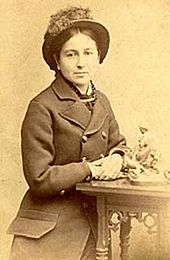Ponca (people)
The Ponca are a North American Indian people from the Dhegiha branch of the Sioux language family , which also includes the Kansa , Omaha , Osage and Quapaw . In the 16th century they separated from the Omaha and settled on the Niobrara River and Ponca Creek in what is now the US states of Nebraska and South Dakota . Their livelihoods were horticulture and buffalo hunting. There are two federally recognized tribes today: The Ponca Tribe of Nebraska and the Ponca Tribe of Indians of Oklahoma .
Residential areas
Under pressure from white immigrants, the Ponca moved westward from the Atlantic coast , having previously lived in Virginia , North, and South Carolina . The early history of the tribe is identical to that of the other tribes in this group. After the entire group migrated to the mouth of the Osage River , they separated. The Quapaw moved south, the Osage stayed there, the Kansa migrated northwest up the Missouri River , while the Omaha and Ponca turned directly north. They moved to what is now Minnesota , where they lived until the late 16th century. Then these two tribes were pushed further west by wandering Dakota . They separated in what is now South Dakota , the Omaha moved on to Bow Creek in what is now Nebraska , while the Ponca settled at the mouth of the Niobrara in the Missouri. In 1673 they appear for the first time on a map by Jacques Marquette . Their tribal lore shows that they had previously lived east of the Mississippi.
Culture
Like other prairie tribes , the Ponca combined agriculture with hunting. They lived in fixed villages with dome-shaped earth huts, while in spring and autumn they went into the hunting season with portable tepees , in which they hunted bison , deer and antelopes . The hairstyle of the warriors consisted of a hair comb on a clean-shaven head, as was common among the southern Sioux tribes . The social organization of the Ponca consisted of a class system with chiefs, priests, doctors and councilors. Social status was inherited in the male line, but an individual could improve his or her personal status by purchasing horses and blankets or by holding celebrations.
history
In 1789 the fur trader Juan Baptiste Munier received an exclusive license to trade fur with the Pawnee on the Niobrara River. He set up a trading post at the confluence of the Niobrara in the Missouri , a place where 800 Ponca lived at that time. Shortly thereafter, a smallpox epidemic struck them and when the Lewis and Clark expedition arrived in 1804, they encountered only 200 tribesmen there.
In 1858 the Ponca signed a treaty in which they surrendered parts of their tribal land to a protected area on the Niobrara River. In 1865 they were granted a reservation in their homeland on the Niobrara, but after a tragic bureaucratic error, the Dakota were given the land and the Ponca were forcibly relocated to Indian territory. The tribe found the living conditions there unbearable and the Ponca soon suffered from malaria , the hot climate and hunger, so that a quarter of them died within the first year. They walked 600 miles (965 km) north under their chief Standing Bear to eastern Nebraska, where they found refuge with the Omaha. There they were captured by soldiers, but after a court hearing sponsored by white sympathizers and through the use of a young Omaha woman named Susette La Flesche , they were released. In 1879, Standing Bear successfully campaigned for Indian rights in court. In 1881, 26,326 acres (106.5 km²) of land in Fort Knox County, Nebraska was returned to the Ponca , and about half of the tribe moved north to the Niobrara River while the rest remained in Oklahoma . The tribe continued to shrink and was officially declared extinct in 1966. In the 1970s there were attempts to recognize the Ponca as a tribe again and on October 31, 1990 they officially became a tribe again with the Ponca Restoration Bill .
Todays situation
The tribesmen living in Oklahoma organized a tribal government in 1950 according to the guidelines of the Oklahoma Indian Welfare Act, passed in 1936 . In the same year they received state recognition under the name Ponca Tribe of Indians of Oklahoma .
In 1990, the Ponca living in Nebraska were also federally recognized under the name Ponca Tribe of Nebraska . As a result, relations between the two tribes improved. One of the most important joint projects is the revival and preservation of the language and cultural traditions.
The Ponca Tribe of Nebraska has its seat of government in Niobrara, Nebraska. The tribal council consists of the chairman, his deputy, the secretary, the treasurer and three council members and is elected for three years.
The seat of government of the Ponca Tribe of Oklahoma is in Ponca City, Oklahoma. The tribal council consists of the chairman, his deputy, a secretary / treasurer and four council members and is elected for four years.
The US census 2000 counted a total of 4,858 tribesmen, of which 258 Nebraska Ponca, 167 Oklahoma Ponca and 4,433 Ponca.
literature
- Raymond J. DeMallie (Ed.): Handbook of North American Indians . Vol. 13 Plains, Smithsonian Institution Press, Washington DC 2001, ISBN 0-16-050400-7 .
See also
Web links
- Encyclopedia of Oklahoma
- Ponca Tribe of Nebraska
- The Ponca Trail of Tears
- Ponca Indian Tribe History
Individual evidence
- ↑ a b c d e f Encyclopedia of Oklahoma - Ponca , accessed December 22, 2011.
- ↑ US Census 2000 , accessed December 19, 2011.


